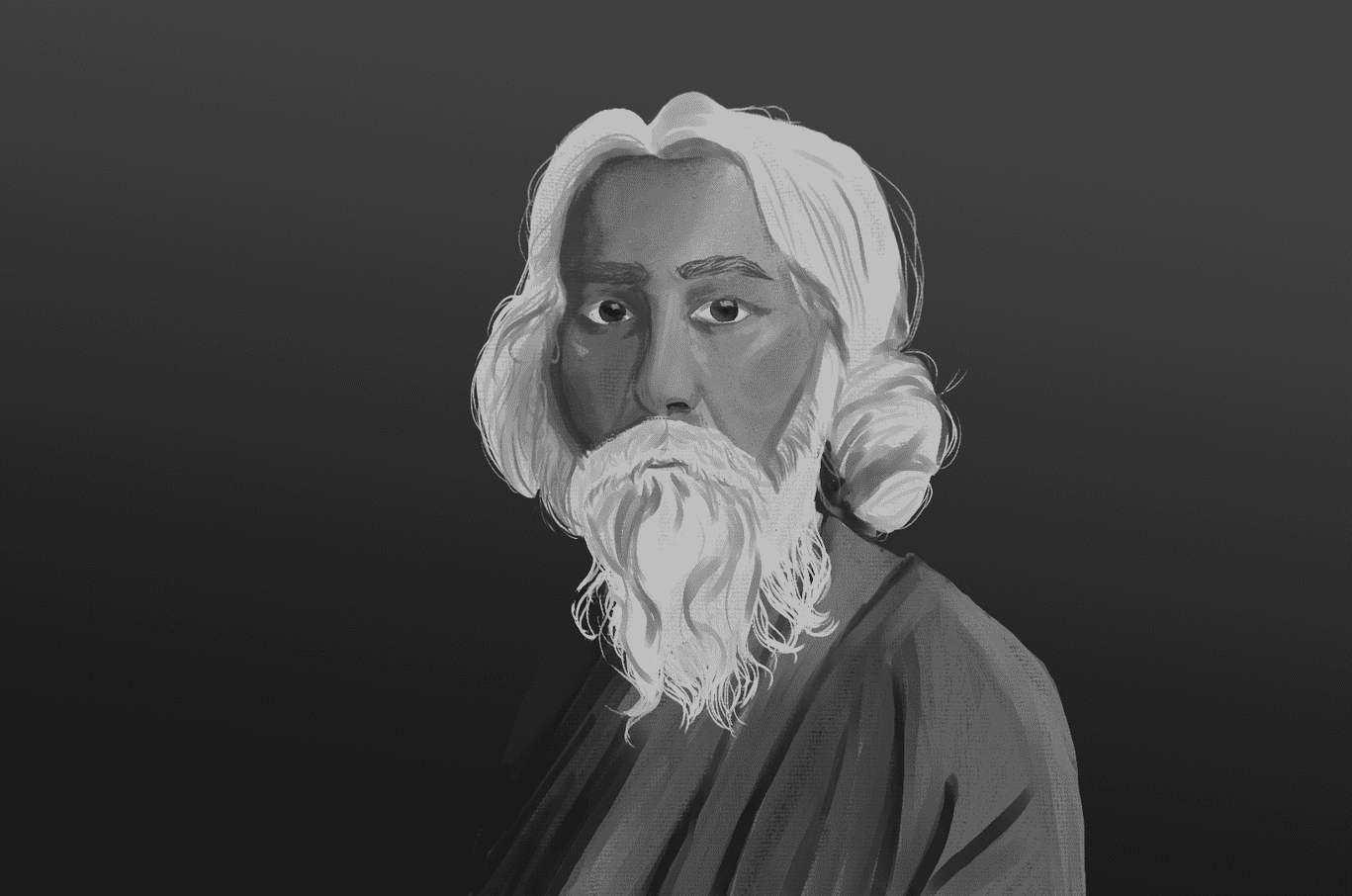Learning from nature: Rabindranath Tagore’s vision
Dr Jyoti teaches at the Department of Elementary Education, Gargi College, Delhi University. As part of her pedagogy, Dr Jyoti encourages her students to publish articles in the journal.

Ayushi Sharma
Ayushi is a B. El. Ed IVth year student at the Gargi College. Ayushi is an aspiring educator passionate about child psychology, focused on inspiring young minds by connecting concepts to nature and their surroundings.
In this article the authors share their school contact experiences on observing that school students were not encouraged to explore connections with the natural surroundings which prevent children from learning from nature in a meaningful way. To Rabindranath Tagore this was essential to not only experience the unity of truth in this world but also to children’s wholesome development.
The story written by polymath Rabindranath Tagore, that is particularly insightful for understanding education, is ‘The Parrot’s Training’. It is a tale of educating a bird who sings but is otherwise ignorant. The king of the province in which the bird lives recruits the best of scholars for his education. To start with, the scholar-teachers decide to get the bird a cage made of gold. He is taught through astute methods, replete with countless books and lessons providing him with an intellectually stimulating environment. One day the king’s officials announce that the bird’s education is complete. Encouraged at the completion of his order to educate the bird; the king goes to meet him only to find that it cannot hop or fly anymore. On a closer look he notices that the bird’s wings are clipped. In fact he had passed away. Nobody seemed to even know how long the bird had been dead.
This story is symbolic of what’s wrong with the education system in our society. Tagore criticized the education system for ignoring child nature, the way the bird’s education ignored who it was, its true nature and swadharma. Instead of nurturing the bird’s natural abilities, the education system imposed an intellectual education that was indifferent to the bird’s nature. It robbed him of his freedom to fly and hindered its growth to the extent that it could not even remain alive.
The second author had a first-hand taste of the parrot-in-the-cage metaphor of education as she embarked on her school internship in the fourth year of her teacher education study. She was assigned to one of the state-run school in the salubrious environs of south Delhi. The students were caged by classrooms, syllabus, books and related implements. The school has a magnificent garden that would attract any passerby. However, students were not encouraged to go there, not even during lunch hours. When she wanted to take the children to the inviting garden as part of a mathematics activity to find round objects in the garden, the principal refused to allow it during teaching hours. She then thought of assigning it as a task for them to do during lunch time but was surprised to learn that the children aren’t even allowed to leave their classrooms during the lunch hour! The teachers of the school mentioned that this is because they need to attend to eating their tiffins. Moreover, playing in the garden may lead to a fall or an injury. She realised that students were simply prohibited from being in the garden. In the previous year of her study, she had read Tagore’s essay My School in which he writes that ‘The young mind should be saturated with the idea that he is born in a human world’(Tagore, 1996, p. 390). In this essay he emphasized on how learning through nature is a key process of education. This to him was the path of what he considered as the aim of education explaining which he writes, ‘The highest education is that which does not merely give us information but makes our life in harmony with all existence’ (ibid).
Contemporary school education is the converse of what is taught to student-teachers in educational studies courses and the aim of school education is mainly to enable children to serve the needs of an information-heavy examination system and acquiring specialization in some field. Emphasis on structures like a tightly framed time table in modern city settings such as the one in which the school mentioned above is located cut young students off from learning from nature. Tagore writes,
“Naturally the soles of our feet are so made that they become the best instruments for us to stand upon the earth and to walk in. From the day we commenced to wear shoes, we minimized the purpose of our feet (Tagore, 1996, p. 392).”
Describing his own childhood aspirations to become one with nature, Bashabi Fraser, Director, Scottish Centre of Tagore Studies writes in 2018,
When Rabindranath Tagore (1861-1941) was a little boy, he longed to step out into the wide world and experience nature, but his early memories are of confinement within Jorasanko, the sprawling Tagore family home in Calcutta. He would watch the outside world through the shutters of their great French windows, from the balcony and terrace, admiring the trees, marvelling at the freedom of little boys diving into the pond outside, fascinated by the women filling pitchers or washing clothes and ducks swimming without a care in the world there. (Frazer, 2018, p. 9).
It was while sitting under the trees, in continuity with the natural world that learning could occur. To Tagore, the city schools with concrete rooms were simply not acceptable as a site for his own children’s education. When the time came,
He moved with his wife and young family to Santiniketan, the ‘Abode of Peace’, and began his school at the ashram established earlier by his father. Rabindranath admired the tapovan, the forest hermitage schools of ancient India, where teacher and students stayed close to nature, sustained by the natural environment, with sowing, harvesting and gardening being part of the lived experience of a holistic education. (Frazer, 2018, p.10).
Tagore’s essay expresses the seed idea for this very school with emphasis on setting it up as a secluded natural habitat far away from the non-natural city landscape. The essay is in fact the transcript of a lecture delivered in the United States of America in 1933. An Indian Social scientist J. M. Kumarappa’s 1928 Ph.D dissertation, at Columbia University in the USA was based on Tagore’s writing on education. It was titled ‘Tagore’s experiment in the Indianisation of education,’ while being supervised by the foremost philosophers of education of that time, John Dewey and W. H. Kilpatrick. Dewey has articulated a philosophy of his own in the celebrated 1929 essay My Pedagogic Creed which remains influential to date, yet did not hesitate in guiding a doctoral student on an alternative innovation in education. In our own department during the teacher-education program, student-teachers have been inspired by Tagore’s educational vision (https://armchairjournal.com/journey-inwards/, https://armchairjournal.com/five-educators-on-education/).
More than a century after its inception, the Santiniketan till today continues to offer a physical space, consisting of a central university, more than a dozen schools, and centres of study, that become part of students’ consciousness. Vishva-Bharati, the university, has been designated as an institution of national importance. All of the schools are affiliated to certification bodies like West Bengal’s School Education Boards among others. This marks the continuity of Tagore-founded institutions with the rest of the country’s education system. These schools have kept Tagore’s timeless vision alive with practices like life-centered education, rural reconstruction while according primacy to literature, culture, and the performing arts. Learning from nature is a key aspect of each of these practices. Change of seasons for example is an enthusiastic celebration on the school campuses highlighting the value of nature observation. Like any other illustrious institution established by an iconic writer, all of these are much sought after by the parents of young children, across varied sections of society, in and around Birbhum district of West Bengal. However, the impact of Tagore’s educational ideas, which are an important inclusion of teacher preparation courses all over the country is minimal, as our school internship experience shows.
Re-visiting the school mentioned at the beginning of this article, the aspiration for teaching in a way that young students can engage with their salubrious surroundings such as the garden that was out-of-bounds for the students; the value of learning through observation and simply being with nature becomes paramount for us as educators.
References
- Tagore, Rabindranath. 1996. The English Writings of Rabindranath Tagore / 2, Plays, Stories, Essays. New Delhi: Sahitya Akad.
- Fraser, B. 2018. ‘Foreword’ in ‘Rabindranath Tagore and the Environment’, Vol. 2, Gitanjali and Beyond, Edinburgh Napier University, The Scottish Centre of Tagore Studies.









Is true was his vision…learning from nature…but I wonder about nature…is about human nature…nature nurtures the natural natural human allegiance as Greek philosopher voltair says men argue nature works…so it is should be about this nature…flesh & blood acclaimed nature…wonder…
To Tagore Nature as it is referred to in the sources that we have cited meant the natural world in which he did include all forms of life and people. You are speaking of human nature or child nature another important element in education. Merits another discussion altogether. Thanks for your perceptive comment.
The article is a beautiful combination of the reality of schools today which clash with the vision of Tagore on education. The green parks and gardens with fun swings,slides etc are merely a showpiece and their actual purpose of providing opportunities to the child to interact with nature and have a holistic development stands defeated.I believe privileged are those students who are in Santiniketan experiencing the nature at its best.
This article powerfully contrasts Tagore’s vision of nature-based education with today’s system of modern schooling.
Tagore’s belief in learning from nature is deeply inspiring, and reminds us to incorporate hands-on, experiential learning into our schools in future. Engaging students in outdoor activities and project-based learning not only helps them grasp concepts more effectively but also sparks their curiosity and enthusiasm to learn.
To create a holistic and enriching educational environment, we must prioritize approaches that combine freedom, creativity, and a connection to nature, preparing students for success in all aspects of life just as Santiniketan embodies Rabindranath Tagore’s vision of a place of learning that is unfettered by religious and regional barriers.